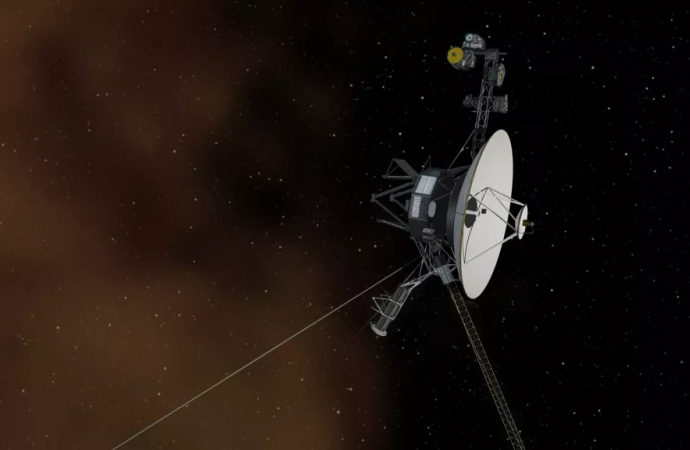Space is big — really big. And if you want to successfully navigate the interstellar depths of our Milky Way galaxy, you’re going to need some sort of reliable system. A new proposal tries to keep the method as simple as possible: use pairs of stars to provide a galactic reference frame.
Source: Space.com
Within our solar system, interplanetary spacecraft rely on Earth-based systems for navigation. When we send a radio signal to a spacecraft and it replies, we can use the time delay of the reply to calculate a distance. We can also monitor the spacecraft in the sky, and by combining all that information (position in the sky and distance from Earth), we can pinpoint the spacecraft’s location in the solar system and provide that information to the spacecraft itself.
We can also use the Doppler shift of those radio waves to estimate the speed at which the spacecraft is moving away from Earth. By using dishes scattered across our planet, we can measure the delay from a spacecraft’s signal reaching one dish versus another. When we combine that data with the position information, we have a complete six-dimensional lock on the spacecraft: its three dimensions of position and its three dimensions of velocity.
This method relies on a network of ground-based radar systems, all in constant communication with the spacecraft. The technique works for spacecraft within the solar system, and, just barely, NASA’s twin Voyager probes.
But any interstellar missions will need a new approach: They will have to navigate autonomously. In principle, these spacecraft could use onboard systems, like clocks and gyroscopes, but interstellar missions will last for decades at a minimum, and tiny errors and uncertainties in those onboard systems will undoubtedly cause those spacecraft to stray off course.
There’s also the option of using pulsars, rotating objects that appear to flicker, or pulsate, at regular intervals. Because each pulsar has a unique rotation period, these objects can serve as reliable beacons for deep-space missions. But this only works within a relatively small bubble near our solar system, because measurements of the rotation period can get contaminated by interstellar dust, and once you lose track of which pulsar is which, you’re lost.
Second star to the right
So interstellar spacecraft need a simple, reliable method of estimating their position within the galaxy. A new paper recently posted to the preprint server arXiv.org offers such a solution: the stars themselves.
The technique is based on a very old concept: parallax. If you stick your finger in front of your nose and alternate closing eyes, your finger will appear to wiggle. The change in its apparent position comes from the new viewpoint as you switch from eye to eye. If you do the same exercise while looking at a distant object, that object will appear to wiggle much less.
It was through parallax that scientists were first able to measure the distance to stars, and it’s through parallax that a spacecraft wandering far from home can get its bearings. Before launch, we load up the spacecraft with an accurate map of all the known stars in our galactic vicinity. Then, as the craft speeds away from the solar system, it measures the relative distances between multiple pairs of stars. As it moves, stars closer to the spacecraft appear to shift significantly, while more distant stars remain relatively fixed.
By measuring multiple pairs of stars and comparing the measurements with the original Earth-based catalog, the spacecraft can figure out which stars are which, and how far away it is from those stars, giving the spacecraft an accurate 3D position in the galaxy.
A relative effect
Getting the velocity of the spacecraft is a little trickier, and it relies on a weird quirk of special relativity. Because of the finiteness of the speed of light, if you’re moving quickly enough, objects can appear to be in different locations than they really are. Specifically, an object’s position will appear to be shifted in the direction of your motion. The effect is called aberration, and it’s measurable from Earth: As our planet orbits the sun, the stars appear to gently sway back and forth in the sky.
As long as the spacecraft is moving quickly enough (and if we want an interstellar mission to last decades, not millennia, it must), onboard systems will be able to measure this aberration. By noting which stars are shifted away from their expected position and by how much, the spacecraft can work out its 3D velocity.
Taken with the parallax measurements, the spacecraft can then recover its complete six-dimensional coordinates within the galaxy; it knows where it is and where it’s going.Advertisement
How precise is this technique? According to the paper, if the spacecraft can measure the positions of just 20 stars to within 1 arc second of accuracy (an arc second is 1/60 of an arc minute, which itself is 1/60 of a degree), it can determine its position within the galaxy to an accuracy of 3 astronomical units (AU) and its velocity to within 2 kilometers per second (1.2 miles per second). One AU is equal to the average distance between Earth and the sun — roughly 93 million miles (150 million km) — so 3 AU is about 279 million miles (450 million km). That sounds like a lot, but it’s peanuts compared to the thousands of AU between stars.
We have accurate positions to way more than 20 stars, so we could load up the spacecraft with a catalog of hundreds of millions of stars to use on its voyage. Each one the spacecraft can measure would help pinpoint its location with even more precision.
Now all we need is an interstellar spacecraft.
Source: Space.com

































Leave a Comment
You must be logged in to post a comment.